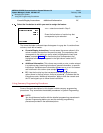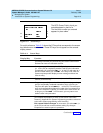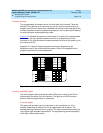
MERLIN LEGEND Communications System Release 6.0
System Manager’s Guide
555-660-118
Issue 1
February 1998
Managing the System
Page 6-9Introduction to System Programming
6
The system programming hierarchy, included in Appendix B of
System
Programming
, details the sequence of screens you work with when you select the
system programming options.
Table 6–2. System Programming Menu Options
Saving Entries and Moving among Screens 6
At the bottom of each screen, one or more screen keys with functions allow you to
change or save your entry or return to a previous screen. Various combinations of
these keys appear on each programming screen. Figure 6–5
shows the QCC
Priority screen with a typical display of screen keys.
Option Description
Set system operating conditions.
Select the system numbering plan and/or reassign extension numbers
with 1- to 4-digit numbers.
Assign or remove operator positions and program operator features
(such as Operator Hold Timer or QCC options).
Program line/trunk options.
Program extensions (for example, with restrictions and lines).
Program systemwide settings (for example, Transfer Return).
Program features that require entering information in a table (such as
Allowed Lists and Disallowed Lists).
Program auxiliary equipment connected to the system (for example,
loudspeaker paging and fax machines).
Program Night Service features.
Program the labels shown on telephone displays (for example, entries
in the System Directory and Posted Messages).
Specify extensions that need voice and data capability.
Print system programming reports (for example, system configuration
and extension assignments).
Perform centralized telephone programming (assign features to specific
buttons on telephones).
Select the language of the system for MLX display telephones, SMDR
reports, and print reports.


















